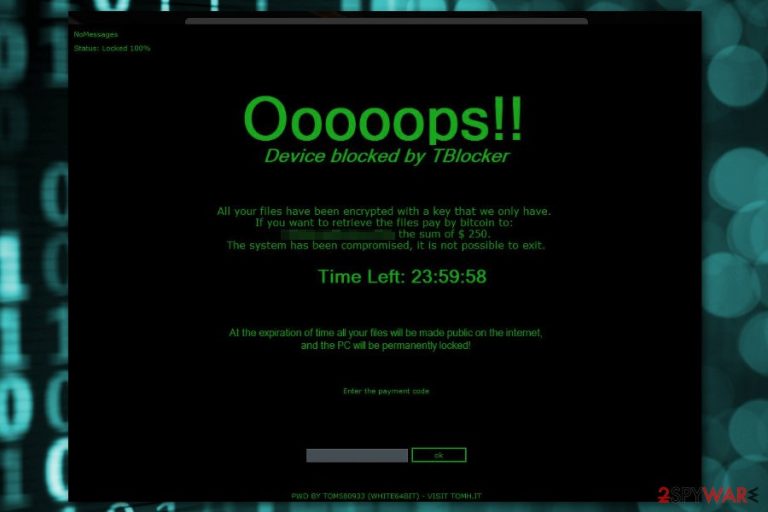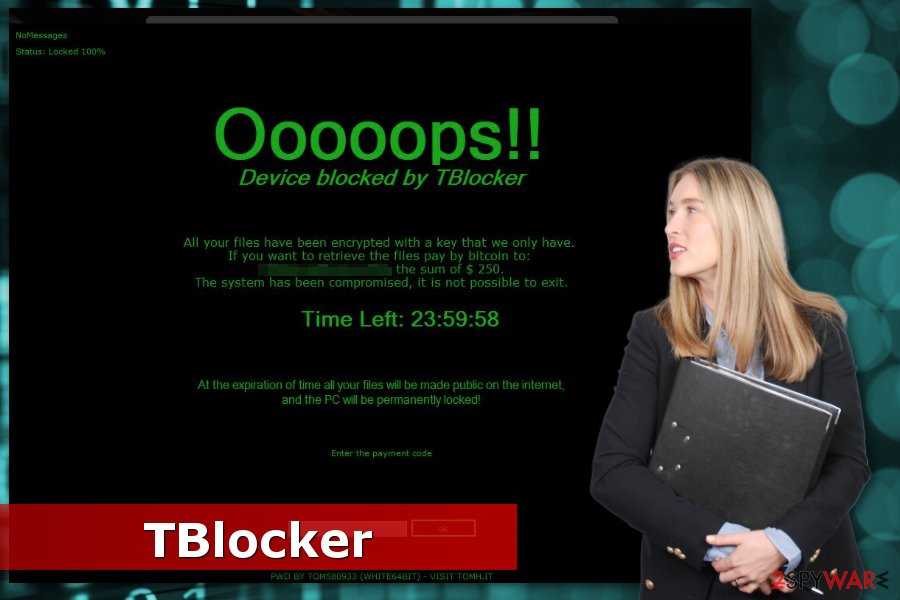TBlocker ransomware (Removal Instructions) - Recovery Instructions Included
TBlocker virus Removal Guide
What is TBlocker ransomware?
TBlocker – ransomware virus that locks the affected computer

TBlocker is a crypto-virus that can encrypt files and lock the computer. Malware displays a threatening lock-screen message where victims are demanded to pay $250 in Bitcoins in 24 hours. Criminals use psychological terror to scare victims by telling that their files will be published online and the computer gets locked forever.
TBlocker ransomware has been spotted spreading in February 2018. Developers of ransomware seem to be using malspam as the main way to infect devices. The TBlocker.exe file is dropped on the system as soon as a user gets tricked by clever social engineering[1] scheme and opens the attached file. Once inside, it starts acting as a regular file-encrypting virus:
- alters Windows registry in order to boot with system startup;
- inject malicious codes into important system processes;
- install many executables to perform various tasks on the system;
- encrypt files;
- might delete Shadow Volume Copies[2] to make data recovery nearly impossible.
Once TBlocker virus finishes all above mentioned tasks, it delivers a ransom note in lock screen window. The message tells:
Ooooops!!
Device blocked by TBlockerAll your files have been encrypted with a key that we only have.
If you want to retrieve the files pay by bitcoin to:
[bitcoin wallet address redacted] the sum of $ 250.
The system has been compromised, it is not possible to exit.Time Left: [Timer counts down the time]
At the expiration of time all your files will be made public on the internet
and the PC will be permanently locked.
However, you should not be threatened by TBlocker ransomware virus. It’s possible to get back access to your device, and you should do it immediately by cleaning your PC with FortectIntego or another malware removal tool.
Unfortunately, data decryption might be complicated or even impossible unless you have data backups. Security programs can only remove TBlocker from the system, but they cannot recover damaged files. For that, you can try third-party tools we offered below the article.
Keep in mind that TBlocker removal should be completed first. While ransomware resides on the system, you won’t be able to use your PC normally and safely. You can find more information about virus elimination at the end of virus description.

Watch our for dangerous emails
The biggest chances to catch a ransomware virus is to open a malicious email attachment. Malware might be included in any Word, Excel, PDF or similar safe-looking file. Hence, you have to make sure that you can actually trust the sender and the added document is real first.
However, researchers from LosVirus.es[3] tell that authors of ransomware might be using other methods to spread their malicious program, such as:
- malvertising,
- fake software downloads or updates;
- drive-by downloads;
- brute-force attacks.
Hence, you should follow general cyber security tips, install a reputable antivirus program and be prepared for ransomware attack by creating data backups.
Delete TBlocker ransomware from the system
To remove TBlocker ransomware, you have to reboot your PC to Safe Mode with Networking. This method allows disabling the virus and installing malware removal software. The instructions below will explain to you how to do it.
When in Safe Mode, you have to install a reputable malware elimination program, such as FortectIntego, SpyHunter 5Combo Cleaner or Malwarebytes. Additionally, you can use your preferred anti-malware tools as well. However, don’t forget to update them before running a system scan.
After TBlocker removal, you can plug in an external drive with backups and recover damaged data. If you do not have them, you should try additional methods that might help you too. You can find these options below.
Getting rid of TBlocker virus. Follow these steps
Manual removal using Safe Mode
Reboot the system to Safe Mode with Networking as shown below to eliminate TBlocker from the PC:
Important! →
Manual removal guide might be too complicated for regular computer users. It requires advanced IT knowledge to be performed correctly (if vital system files are removed or damaged, it might result in full Windows compromise), and it also might take hours to complete. Therefore, we highly advise using the automatic method provided above instead.
Step 1. Access Safe Mode with Networking
Manual malware removal should be best performed in the Safe Mode environment.
Windows 7 / Vista / XP
- Click Start > Shutdown > Restart > OK.
- When your computer becomes active, start pressing F8 button (if that does not work, try F2, F12, Del, etc. – it all depends on your motherboard model) multiple times until you see the Advanced Boot Options window.
- Select Safe Mode with Networking from the list.

Windows 10 / Windows 8
- Right-click on Start button and select Settings.

- Scroll down to pick Update & Security.

- On the left side of the window, pick Recovery.
- Now scroll down to find Advanced Startup section.
- Click Restart now.

- Select Troubleshoot.

- Go to Advanced options.

- Select Startup Settings.

- Press Restart.
- Now press 5 or click 5) Enable Safe Mode with Networking.

Step 2. Shut down suspicious processes
Windows Task Manager is a useful tool that shows all the processes running in the background. If malware is running a process, you need to shut it down:
- Press Ctrl + Shift + Esc on your keyboard to open Windows Task Manager.
- Click on More details.

- Scroll down to Background processes section, and look for anything suspicious.
- Right-click and select Open file location.

- Go back to the process, right-click and pick End Task.

- Delete the contents of the malicious folder.
Step 3. Check program Startup
- Press Ctrl + Shift + Esc on your keyboard to open Windows Task Manager.
- Go to Startup tab.
- Right-click on the suspicious program and pick Disable.

Step 4. Delete virus files
Malware-related files can be found in various places within your computer. Here are instructions that could help you find them:
- Type in Disk Cleanup in Windows search and press Enter.

- Select the drive you want to clean (C: is your main drive by default and is likely to be the one that has malicious files in).
- Scroll through the Files to delete list and select the following:
Temporary Internet Files
Downloads
Recycle Bin
Temporary files - Pick Clean up system files.

- You can also look for other malicious files hidden in the following folders (type these entries in Windows Search and press Enter):
%AppData%
%LocalAppData%
%ProgramData%
%WinDir%
After you are finished, reboot the PC in normal mode.
Remove TBlocker using System Restore
-
Step 1: Reboot your computer to Safe Mode with Command Prompt
Windows 7 / Vista / XP- Click Start → Shutdown → Restart → OK.
- When your computer becomes active, start pressing F8 multiple times until you see the Advanced Boot Options window.
-
Select Command Prompt from the list

Windows 10 / Windows 8- Press the Power button at the Windows login screen. Now press and hold Shift, which is on your keyboard, and click Restart..
- Now select Troubleshoot → Advanced options → Startup Settings and finally press Restart.
-
Once your computer becomes active, select Enable Safe Mode with Command Prompt in Startup Settings window.

-
Step 2: Restore your system files and settings
-
Once the Command Prompt window shows up, enter cd restore and click Enter.

-
Now type rstrui.exe and press Enter again..

-
When a new window shows up, click Next and select your restore point that is prior the infiltration of TBlocker. After doing that, click Next.


-
Now click Yes to start system restore.

-
Once the Command Prompt window shows up, enter cd restore and click Enter.
Bonus: Recover your data
Guide which is presented above is supposed to help you remove TBlocker from your computer. To recover your encrypted files, we recommend using a detailed guide prepared by 2-spyware.com security experts.If your files are encrypted by TBlocker, you can use several methods to restore them:
Try to restore data with Data Recovery Pro
This tool is created for restoring files after system damage or accidental deletion of the files. However, it sometimes helps victims of ransomware.
- Download Data Recovery Pro;
- Follow the steps of Data Recovery Setup and install the program on your computer;
- Launch it and scan your computer for files encrypted by TBlocker ransomware;
- Restore them.
Windows Previous Versions feature helps to get back the most important files
If System restore was enabled before TBlocker attack, you can copy individual files by following these steps:
- Find an encrypted file you need to restore and right-click on it;
- Select “Properties” and go to “Previous versions” tab;
- Here, check each of available copies of the file in “Folder versions”. You should select the version you want to recover and click “Restore”.
Try ShadowExplorer
To recover files with ShadowExplorer, you have to be sure that malware did not delete Shadow Volume Copies.
- Download Shadow Explorer (http://shadowexplorer.com/);
- Follow a Shadow Explorer Setup Wizard and install this application on your computer;
- Launch the program and go through the drop down menu on the top left corner to select the disk of your encrypted data. Check what folders are there;
- Right-click on the folder you want to restore and select “Export”. You can also select where you want it to be stored.
TBlocker decryptor is not released yet
Finally, you should always think about the protection of crypto-ransomwares. In order to protect your computer from TBlocker and other ransomwares, use a reputable anti-spyware, such as FortectIntego, SpyHunter 5Combo Cleaner or Malwarebytes
How to prevent from getting ransomware
Choose a proper web browser and improve your safety with a VPN tool
Online spying has got momentum in recent years and people are getting more and more interested in how to protect their privacy online. One of the basic means to add a layer of security – choose the most private and secure web browser. Although web browsers can't grant full privacy protection and security, some of them are much better at sandboxing, HTTPS upgrading, active content blocking, tracking blocking, phishing protection, and similar privacy-oriented features. However, if you want true anonymity, we suggest you employ a powerful Private Internet Access VPN – it can encrypt all the traffic that comes and goes out of your computer, preventing tracking completely.
Lost your files? Use data recovery software
While some files located on any computer are replaceable or useless, others can be extremely valuable. Family photos, work documents, school projects – these are types of files that we don't want to lose. Unfortunately, there are many ways how unexpected data loss can occur: power cuts, Blue Screen of Death errors, hardware failures, crypto-malware attack, or even accidental deletion.
To ensure that all the files remain intact, you should prepare regular data backups. You can choose cloud-based or physical copies you could restore from later in case of a disaster. If your backups were lost as well or you never bothered to prepare any, Data Recovery Pro can be your only hope to retrieve your invaluable files.
- ^ Ben Rose. Social engineering: cyber criminals that want to hack your brain. Digital Risks. The blog about business, technology and security.
- ^ Shadow Copy. Wikipedia. The free encyclopedia.
- ^ Los Virus. Los Virus. Spanish cyber security news.







